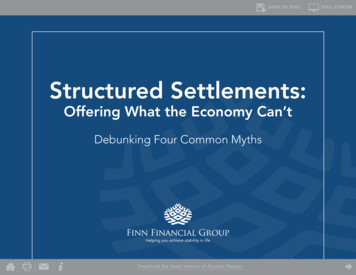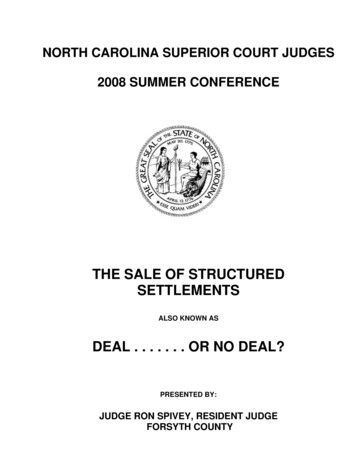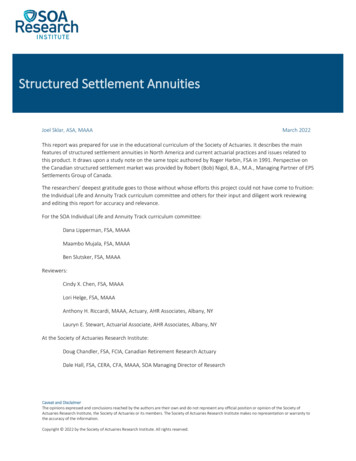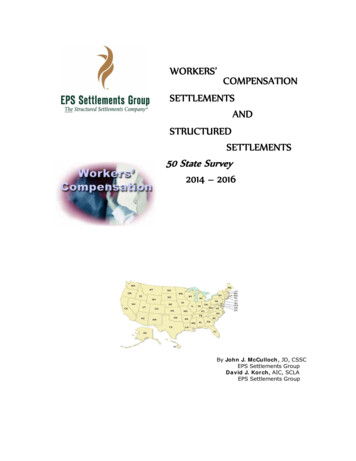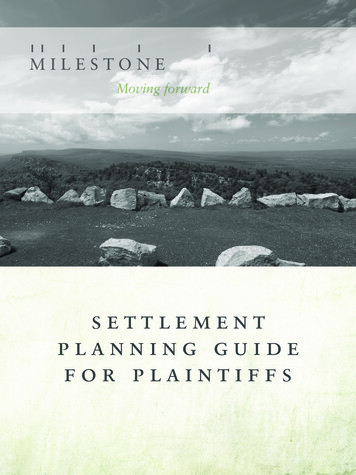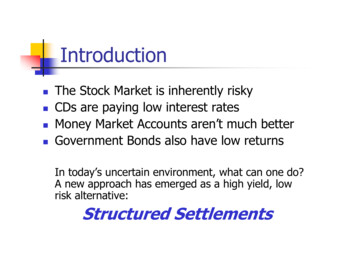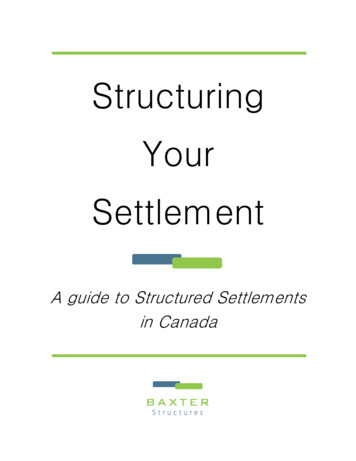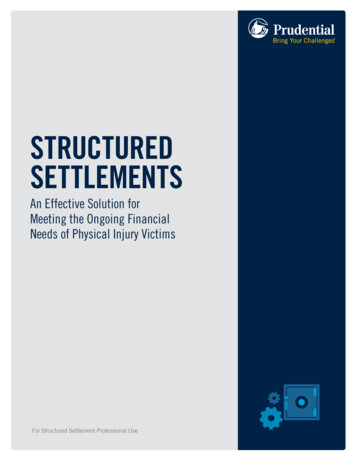
Transcription
StructuredSettlementsAn Effective Solution forMeeting the Ongoing FinancialNeeds of Physical Injury VictimsFor Structured Settlement Professional Use
2
Executive summaryStructured settlements have played a role in helping physical injury victims and their families formore than a quarter century. Relieving individuals from the responsibility of managing significantsums of money, structured settlements deliver fixed streams of payments that can help address theongoing needs of those involved in physical injury and wrongful death claims.The federal government has established tax incentives that make this solution particularly effective.Structured settlements have been endorsed by attorneys, legislators, guardians ad litem, judges anddisability advocates.Despite these endorsements, there is a general lack of awareness regarding structured settlements.When presented with the option, most individuals select lump sum payments over structuredsettlements.This paper is intended to increase the understanding and awareness of structured settlements. Itlooks at the benefits of structured settlements, comparing them to their lump sum counterparts andexamining the advantages and distinctions.For purposes of clarity, this paper focuses specifically on “qualified” structured settlements—thosethat qualify for favorable tax treatment.1 It is worth noting, however, that structured settlementscan also be used in situations other than physical injury or wrongful death claims. Nonqualifiedstructured settlements—or those involving claims not resulting from personal physical injury orphysical sickness, and as a result, not qualifying for tax-free status—can be used for attorney fees,employment disputes, discrimination cases, property damage claims, environmental torts, divorcesettlements, and more.Of course, no one solution is appropriate for everybody, and there are potential disadvantages toconsider. Some individuals may feel constrained by the defined schedule of periodic payments thatstructured settlements provide. For example, an individual who enters into a structured settlementand later seeks to purchase a home or other expensive item may not be able to accrue the necessaryresources because he or she is unable to borrow against future payments under the settlement.Also, if individuals are experienced, knowledgeable investors, they may be better served by acceptinga lump sum settlement and investing it themselves. Further, there is the improbable scenario of aninsurer becoming insolvent over time and defaulting on the agreed-to structured settlement payments.However, these examples are the exceptions, and structured settlements have proven time and againto be an effective means for compensating physical injury and wrongful death claimants.“Qualified” as meeting the requirements of paragraphs (1) or (2) of section 104(a) of the Internal Revenue Code.13
‘‘’’‘‘‘‘’’ he structured settlement has proven so effective at keeping seriously injuredTand disabled Americans off public assistance that Congress amended thetax code to allow for increased use of structured settlements in workers’compensation cases.— William T. Robinson III, Esq.Former president of the American Bar Association Structured settlements constitute a private sector funding alternative totaxpayer-financed assistance programs to meet the ongoing, long-term medicalexpenses and basic living needs of seriously injured victims and their families.— Hon. John LewisCivil rights leader and member of Congress ’’Many accident victims don’t appreciate the roles that risk and volatility havein investing. Short-term volatility, particularly in the early years, can put yourfuture funding at risk. With a structured settlement, you don’t havethat problem.Quotes courtesy of the National Structured Settlements Trade Association.4— Frank ReillyProfessor of FinanceUniversity of Notre Dame Business School
Table of ContentsIntroduction.6Why structured settlements?.8Designing the structured settlement payment plan. 10Structured settlement transaction. 12The structured settlement marketplace. 14Choosing a structured settlement provider. 16The emergence of the factoring market. 17The future of structured settlements. 18Conclusion. 195
IntroductionStructured settlements have proven to be an effective solution for compensatingclaimants in physical injury, wrongful death and workers’ compensation claims.Consisting of a tailored stream of payments designedto help meet physical injury victims’ ongoing financialneeds, structured settlements are typically backed byan annuity from an insurance company. The amountand frequency of the payments are dictated by theclaimants’ present and future requirements, as well astheir personal financial goals.Made in lieu of, or in addition to, an immediate lumpsum payment, structured settlements can be beneficialto claimants and defendants alike.Offering financial security to physical injury victimsand their families, structured settlements are paid inpreestablished installments over time, providinglong-term, tax-free income. If properly arranged,structured settlements offer the potential of deliveringgreater benefits and a higher net return than lumpsum payments.Structured settlements can be agreed to privately—such as in a pretrial settlement between the claimantand defendant—or they can be decreed by courtorder, which is often required in legal judgmentsinvolving minors.26Pursuant to paragraphs (1) or (2) of section 104(a) of the Internal Revenue Code.Payments, including growth on the original amountstructured, are income tax-free to the claimant2and can be customized to meet the claimant’s needs,such as medical costs, modified vehicles, educationalexpenses or basic living expenses.This is an important facet of structured settlements,as each individual’s requirements are distinctive,and structured settlements can be plannedwith consideration to the claimant’s particularcircumstances.Further, structured settlements can protect claimantsfrom dissipation—the potentially imprudent spendingof settlement funds. The task of managing large sumsof money can prove difficult for some individuals,particularly those dealing with a physical injury,disability or wrongful death.
History of the structured settlements industry71919The Revenue Act of 1918 excluded personal injury awards from taxableincome. Presently codified as Internal Revenue Code (I.R.C.) §104(a)(2).1979The IRS issued Private Letter Ruling 79-220, which provided that a recipientof a personal injury award paid as periodic payments may exclude the fullamount of the payments from gross income under I.R.C. §104(a)(2), andthat payments made to the estate after the recipient’s death are also fullyexcludable from taxable income.1983The Periodic Payment Settlement Act of 1982 clarified that personal injuryawards, whether paid as a lump sum or as periodic payments, are excludedfrom gross income. It further created I.R.C. §130 to allow defendants totransfer their future periodic payment obligations via a qualified assignment.1984The National Structured Settlements Trade Association (NSSTA) wasfounded. The NSSTA serves as the leading voice of the structuredsettlements industry.1996The Small Business Job Protection Act amended I.R.C. §104(a)(2) to limitthe types of personal damages excludable from gross income to “personalphysical injuries or physical sickness.” It also eliminated the exclusion forpunitive damages.1997The Taxpayer Relief Act of 1997 amended I.R.C. §130(c) to extend the use ofqualified assignments for structured settlements in workers’ compensationclaims filed after August 5, 1997.2006Cumulative sales of structured settlement annuities surpassed 100 billion.2013The bipartisan Congressional Structured Settlement Caucus was formedto help educate members of Congress on the importance of structuredsettlements to people with serious injuries. 100 billion
Why structured settlements?Before the emergence of structured settlements, claimants in physical injury or wrongfuldeath settlements were presented with one option: an immediate cash settlement in theform of a lump sum payment.Along with this payment came the challenge ofmanaging a large sum of money. Many claimants foundthey were unprepared to meet this challenge, and spenttheir settlement funds quickly and negligently.This mismanagement of settlement proceeds has beena point of concern in the physical injury/wrongful deathsettlement space for some time. Statistical data showsthat injury victims often dissipate their funds within justa few years of the settlement. In fact, in a 2013 surveyof those claimants who accepted a lump sum settlementmore than three years ago, 30% now think they haveless money remaining than they expected.3 In an earliersurvey, 57% of those who took a lump sum reported thattheir entire settlement amount was depleted.4Structured settlements can safeguard claimants againstdissipation and eliminate the risk and worry associatedwith managing a large sum of money. When you considerthat the financial markets have experienced significantdeclines twice in the past 13 years (see Exhibit 1), youcan see how reassuring the consistent income streamof a structured settlement can be—particularly to anindividual who has been seriously injured or disabled.Exhibit 1: Market Volatility 2000-2013S&P 500 Index ( SPX)—Index 0700.00348Source: 2013 Prudential Structured Settlements Claimant Survey.American General Life Companies Structured Settlement Survey Report, 2012.3,231Dec.01,231Dec.0121Dec.31,201031,2019S&P 500 Index ( SPX)—Index 31Dec.Dec.31,20001500.00
In addition to this protection against dissipation,structured settlements: Provide income tax-free periodic payment streamsdesigned to meet the individual needs andcircumstances of claimants and their families; May include a lifetime payment stream to help mitigatethe risk of claimants outliving their assets; Offer increased financial security, as the periodicpayments are funded by an annuity contract issued bya highly rated life insurance company or through anobligation of the United States;5 May lead to quicker settlements and avoid the risk andexpense associated with a jury trial; and May lessen expenses associated with resolving the claim.What’s more, structured settlements may offer rates ofreturn comparable to traditional investment vehicles,Structured SettlementInternal Rate of Return5915% TaxBracket25% TaxBracketsuch as fixed-income investments. As stated previously,the payments received from a properly designedstructured settlement are income tax-free, while theinvestment income earned from a lump sum settlementcan be fully taxable. Accordingly, over time anappropriately designed structured settlement has thepotential of resulting in a larger overall net return thana lump sum payment.To gauge the value of this tax exemption—keepingin mind the rate of return on a structured settlementis guaranteed—one must compare the rate of returna lump sum settlement must achieve to match thesame rate of return as an income tax-free structuredsettlement. As indicated in the chart below, a lump sumsettlement recipient in the 28% tax bracket would haveto invest at a 5.56% net rate of return to achieve thesame earnings a structured settlement recipient wouldachieve using an annuity with a 4% rate of return.28% TaxBracket30% TaxBracket33% TaxBracket35% 9.72%10.00%10.45%10.77%Pursuant to Internal Revenue Code section 130(d), an annuity contract or any obligation of the United States government may be used to fund a structured settlement.
Designing the structured settlement payment planStructured settlement payment plans are customized to meet the individual needs andcircumstances of physical injury victims and their families.A structured settlement should be considered as anoption in most cases involving personal physical injuryor physical sickness, but are particularly appropriate forcases involving: Temporary or permanent disability Wrongful death—especially in situations wheresurviving family members require monthly or annualincome Workers’ compensation Minors or incapacitated adults (courts generally donot allow disbursements directly to these individuals) Claimants who are uncomfortable or unfamiliar withmanaging moneyA structured settlement consultant—that is, alicensed professional who specializes in structuredsettlements—should be engaged in the settlementnegotiations early to assist in designing a plan thatmeets the claimant’s needs. A structured settlementconsultant may be brought into the negotiationsby the claimant, the insurer/self-insured, or both.With structured settlements, claimants may wishto fund future educational expenses, enhance theirretirement funds, address medical expenses or providefor their overall financial well-being. Based on theclaimant’s input and unique needs, the structuredsettlement consultant can tailor the payment plan toaccommodate nearly any scenario.To achieve income tax-free status under the InternalRevenue Code, structured settlement payment plansmust be determined before the settlement is finalized,with the timing and amount of each payment clearlyestablished. In addition, once the dates and amountsof each payment have been agreed to, the claimantmay not increase or decrease the payment amounts, oraccelerate or defer the payment streams.6Internal Revenue Code section 130(c)(2).Check with the individual life insurance company for underwriting guidelines.6710Payment plans may include an up-front, lump sumpayment that can be used to cover attorney fees andother expenses, with the rest being paid bi-weekly,monthly, quarterly, semi-annually or annually.7 Thepayments can be scheduled for a designated period oftime, or for the claimant’s lifetime. Future lump sumpayments can also be included to address large costsyet to come. And ongoing payments can be in levelamounts, or can include a cost-of-living adjustment,which is prearranged to address expected futureincreases in medical costs and basic living expenses.Some insurance companies offer joint and survivor lifeannuities, depending on the nature of the settlement.For non-life contingent payments—payments maderegardless of whether the claimant is living—structuredsettlements can allow for designated beneficiaries tocontinue to receive the future payments tax-free in theevent of the claimant’s premature death.The following are some examples of structuredsettlement payment plans: In cases involving minors, the settlement canbe structured to provide for expenses duringchildhood; subsequent disbursements to payfor college or other educational expenses; andthen additional payments during the claimant’sadulthood—even into retirement. In cases involving individuals with long-term specialneeds, the settlement can be structured in sucha way as to pay for rehabilitation or permanentcare facility expenses later in life, and provide fordisbursements to purchase medical equipment ormodified vehicles. The settlement can also includea cost-of-living adjustment to help cover futureincreases in these expenses.
Case illustration: A structured settlement provides peace of mindWhen a 45-year-old husband and father was seriouslyinjured in an accident, he was forced to take time offfrom his job at a manufacturing company. And whenhis case was settled, he had to make an importantdecision: whether to receive a lump sum paymentor a structured settlement.Anthony was living the American dream. He had a goodjob, a loving family, a nice home and an extremelybright future. But when an accident left Anthonypartially disabled and unable to work for a period oftime, his financial outlook suddenly becamevery uncertain.of a structured settlement. With the help of astructured settlement consultant, Anthony weighedhis options, and determined that a structuredsettlement was the smart choice for his family.With the structured settlement, all payments Anthonyreceives are tax-free; there are no trust expensesor ongoing management fees; and he receives fullpayments even though he has returned to work.What’s more, the structured settlement provided theopportunity for Anthony to customize future paymentsto assist with his family’s anticipated monthly expensesand educational costs.Fortunately, Anthony was able to settle his physicalinjury case, and was presented with the choice ofreceiving his payment as a lump sum, or in the formHere’s how Anthony structured his physical injury settlement to address his presentand future requirements: 300,000 SettlementAttorney Fees 100,000Cash at Settlement 15,000Structured Settlement 185,000Benefits: 500 per month for 20 years guaranteed with 3% cost-of-living-adjustment to assist withmonthly expenses (years 1–20) 15,000 per year for four years guaranteed to assist with son’s college tuition (years 5–8) 50,000 lump sum at retirement (year 20)Total Guaranteed StructuredSettlement Payments 271,222.25 (includes income-tax free growth of 86,222.25)Total Value of Settlement 386,222.25Note: Based on a 3.51% internal rate of return.11
Structured settlement transactionWhen a settlement is reached on the benefits due to a physical injury victim (which cantake place prior to, during, or after a lawsuit), the defendant agrees to fund a stream ofpayments that will meet the claimant’s needs.Once the periodic payment plan has been agreed uponby the parties, an annuity contract is purchased to fundthe payments under the structured settlement. Thiscan be accomplished in one of two ways:In the first scenario, the defendant—often a propertyand casualty insurance company—decides to maintainthe periodic payment obligation, and funds it bypurchasing an annuity from a life insurance company,thereby offsetting its obligation with a matching asset.The annuity matches the periodic payments as set forthunder the terms of the settlement agreement. Thesetypes of cases are “unassigned,” meaning the propertyand casualty insurance company retains the ongoingsettlement liability obligations—along with ownershipof the annuity—and directs the annuity issuer to sendpayments directly to the claimant. Exhibit 2 illustratesthe mechanics of an “unassigned” structuredsettlement transaction.8Exhibit 2: Unassigned Structured Settlement TransactionDefendant Maintains Periodic Payment Obligations“Unassigned”Annuity PurchasePremium PaymentDefendant/P&C carrierDuty to makePaymentsClaimant/Payee812Check with the individual life insurance company for underwriting guidelines.Annuity ContractAnnuity Paymentsare paid as a matterof administrativeconvenienceInsuranceCompany
In the second and most common scenario, pursuant toInternal Revenue Code section 130(c), the defendantenters into a qualified assignment of the periodicpayment obligation. The assignment is considered“qualified” because the settlement proceeds areexcluded from income taxes under paragraph (1) or (2)of section 104(a) of the Internal Revenue Code, andthe liability to make the periodic payments is assignedpursuant to Internal Revenue Code section 130.In a qualified assignment, the defendant transfers, or“assigns,” the liability and responsibility of makingperiodic payments to a third-party assignmentcompany. The assignment company—typically anaffiliate of the life insurer providing the annuity—requires that the defendant pay an amount sufficient topurchase an annuity, which funds the periodic paymentobligation.9 Once the assignment is executed, thedefendant has no further liability to make the periodicpayments. The assignment company purchases theannuity from a life insurance company to fund itsobligation to make the periodic payments and directsthe annuity issuer to send payments directly to theclaimant. Exhibit 3 illustrates the mechanics of anassigned structured settlement transaction.10It is important to note that in accordance with theInternal Revenue Code, a claimant may not own norcontrol the annuity contract. As discussed, if theclaimant accepted a lump sum payment to settle apersonal physical injury or physical sickness claim,the lump sum would be income tax-free, but theclaimant would have to pay income taxes on anyincome earned on the investment of the lump sum.Taking ownership or control of the annuity contractwould be the equivalent of the claimant receiving alump sum payment. Accordingly, ownership is eitherretained with the defendant/property and casualtycarrier or, in the event of an assignment, ownershipis retained by the assignment company, and theclaimant has a right to receive the future periodicpayments as they become due.Exhibit 3: Assigned Structured Settlement TransactionDefendant Transfers Periodic Payment Obligations“Assigned”Defendant/P&C carrierAssignmentAnnuity PurchaseLump Sum PaymentPremium PaymentAssignment AgreementAssignmentCompanyDuty to makePaymentsRelease fromTort Liability9The assignment company may charge a one-time nominal assignment fee.Check with the individual life insurance company for underwriting guidelines.1013Claimant/PayeeAnnuity ContractAnnuity Paymentsare paid as a matterof administrativeconvenienceInsuranceCompany
The structured settlement marketplaceSince its inception in the 1970s, the structured settlement marketplace has generatedover 140 billion in cumulative premium through 2013.11From 150 million in premium in 1979, thestructured settlement marketplace expanded to over 4 billion in premium in 1999.12 Between 2000 and2008, the industry saw significant growth, with salesof structured settlement annuities climbing steadilyto a peak of 6.4 billion.13 As with most financialindustries, the structured settlements market wasaffected by the economic downturn of 2008 to 2012,and experienced a decline in sales. However, 2013saw a resurgence in transactions (see Exhibit 4), andthe outlook for the industry is positive—particularlywhen you consider that between 2008 and 2012, fixeddeferred annuity sales declined 37%, while structuredsettlement sales only decreased 25%.14 What’s more,consumer demand for future income protection isexpected to remain strong.However, a general lack of awareness among claimantsand attorneys continues to impact growth in thestructured settlement marketplace—and precludesclaimants from the benefits and security structuredsettlements can provide.Most claimants have limited knowledge of thesettlement options available to them, and tend to lookto their attorney for guidance. A 2013 survey revealedthat attorneys are extremely influential and affectdecision making within the realm of personal injuryand wrongful death litigation. In fact, more than twothirds of claimants who chose structured settlementsbecame aware of the option through their attorneys,and 58% said their attorney was most influential intheir decision to choose a structured settlement.15Exhibit 4: Sales in BillionsStructured Settlement Industry Sales 1975 —2013 7,000,000,000 6,000,000,000 5,000,000,000 4,000,000,000 3,000,000,000 2,000,000,000 1,000,000,000Sources: 1975–1998, Quarterly Summary of the United States Settlement Annuity Provider Premium, Melissa Evola Price, February 2014; 1999–2013,LIMRA Quarterly U.S. Individual Annuity Reports.12 Sources: 1975–1998, Quarterly Summary of the United States Settlement Annuity Provider Premium, Melissa Evola Price, February 2014; 1999–2013,LIMRA Quarterly U.S. Individual Annuity Reports.13LIMRA Quarterly U.S. Individual Annuity Reports.14LIMRA Quarterly U.S. Individual Annuity Reports.15Source: 2013 Prudential Structured Settlements Claimant Survey.11 19761975 -
As such, attorneys have numerous opportunities toinform claimants about the advantages of structuredsettlements. Nonetheless, appreciation of structuredsettlements amongst the legal community remains low.These findings are consistent with a prior survey inwhich individuals with no connection to a personalinjury case were presented with two hypotheticalpersonal injury scenarios. Without being educated onthe differences between lump sums and structuredsettlements, 65% chose a lump sum. Conversely, aftersurvey respondents became more educated on the1615American General Life Companies Structured Settlements Survey Report, 2012.differences, 73% of these individuals indicated theywould have selected a structured settlement, while only27% would have chosen a lump sum.16Together, the findings of these surveys highlight asignificant opportunity to educate both attorneysand claimants by providing them with morestructured settlements information and resources.With heightened awareness and understanding,more physical injury, wrongful death and workers’compensation claimants might avail themselves of themany advantages of a structured settlement.
Choosing a structured settlement providerWhen selecting a structured settlement provider, it is important to evaluate thecompany’s financial strength and stability, as well as a number of other qualities,such as its: Conservative, fixed-income asset managementapproach History of life insurance expertise Dedication to service, quality and excellence Long-term commitment to the marketplace Product features Underwriting guidelinesOf course, competitive pricing and brand recognition/awareness should also factor into the decision-makingprocess.The annuity company selected should be among thestrongest life insurance firms in the industry, with highratings from the following independent rating agencies:A.M. Best Company, Standard & Poor’s, Moody’sInvestors Service and Fitch Ratings. While theseratings should not be the sole determining factor inthe decision, they should play a key role. In effect, thechosen company should demonstrate superior financialstrength, outstanding credit ratings, a reputation forcustomer service, and a track record of being a toplevel provider in the structured settlement marketplace.16Insurance companies that issue structured settlementannuities are subject to strict regulation by the statesin which they do business. State insurance regulationsrequire annuity providers to be solvent and able tomeet their claims-paying obligations. The insurersmust maintain required capital and reserves, andare periodically evaluated by the independent ratingagencies. Each of the following state-mandatedsafeguards is intended to help enhance an insurer’sability to pay claims and protect its policyholders: Statutory reserves. State-mandated reserves thatinsurance companies must hold, either as cash ormarketable investments. Represents the estimatedamount needed to fund future policyholder benefits. Cash flow testing. Evaluates an insurer’s ability tomeet its contractual obligations under a variety ofmarket environments. Minimum risk-based capital. Assets in excess ofthe amount required to fund all liabilities. Ensuresstakeholders will still receive payments in the eventof insolvency.In addition to the above, insurance companies mayhold excess capital and surplus to provide another layerof financial protection against economic volatility.
The emergence of the factoring marketFactoring transactions occur when recipients of structured settlement payments agree totransfer the right to receive future payments to a third party in return for an immediate,discounted lump sum payment.Structured settlement payment plans are designedto meet the current and future financial needs ofphysical injury victims and their families. Occasionally,circumstances change, and the claimants believe thatthe agreed-upon payment plan no longer meetstheir needs.Consequently, the 1990s saw the advent of a new,secondary market in the structured settlement industry.This secondary market, known as the “factoring”market, was born from the need of some claimantsto relinquish all or a portion of their agreed-uponstructured settlement benefits in return for animmediate, discounted lump sum payment.Congress began regulating the sale of income tax-freestructured settlements to third parties in 2001 to helpsafeguard physical injury victims from jeopardizing theirfinancial future by relinquishing the future value of theirbenefits for a lesser lump sum.17 This legislation createdInternal Revenue Code section 5891.Section 5891 requires that an order be acquired froma court of law within the state in which the annuitantresides, in agreement with that state’s StructuredSettlement Protection Act. If there is no StructuredSettlement Protection Act in the state in which theannuitant lives, then the court order can be obtained inthe state where the insurance company is domiciled, inaccordance with the Structured Settlement ProtectionAct in that state. Underscoring the critical need toprotect recipients of structured settlement payments,171817this section imposes a 40% excise tax on purchasersof structured settlement payment rights (“factoringcompanies”) that fail to obtain a qualified order incompliance with the applicable state StructuredSettlement Protection Acts. This excise tax, which isessentially a penalty tax, is charged on the profit earnedby the factoring company from said transactions.Nearly all states and the District of Columbia haveenacted a Structured Settlement Protection Act. TheseActs require the factoring company to provide certaindisclosures
8 3Source: 2013 Prudential Structured Settlements Claimant Survey. 4American General Life Companies Structured Settlement Survey Report, 2012. Why structured settlements? Before the emergence of structured settlements, claimants in physical injury or wrongful death settlements were presented with one option: an immediate cash settlement in the
